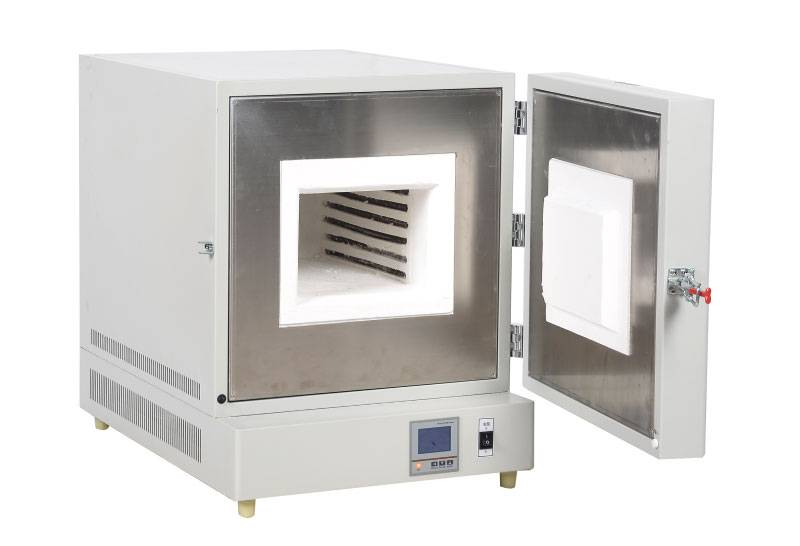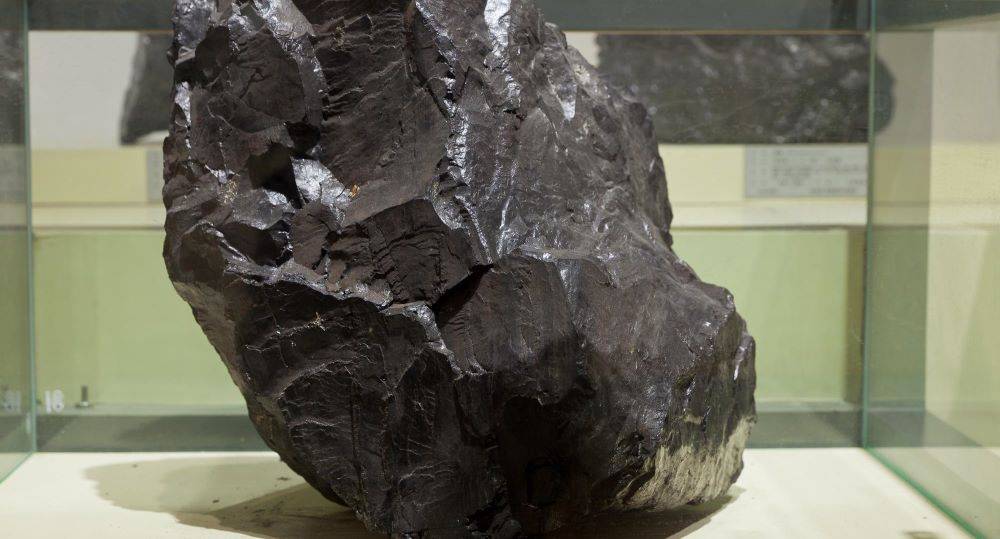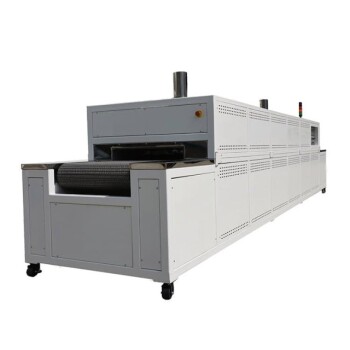Prinzip und Aufbau von Muffelöfen
Arten von Muffelöfen
Muffelöfen in Laboratorien gibt es in verschiedenen Formen, die sich jeweils durch ihre einzigartigen Heizprinzipien und Anwendungen unterscheiden. Zu den gebräuchlichsten Typen gehören Elektro-, Mikrowellen- und Gasmuffelöfen, die jeweils auf spezifische Bedürfnisse in der wissenschaftlichen Gemeinschaft zugeschnitten sind.
Elektrische Muffelöfen werden wegen ihrer Vielseitigkeit bei Aufgaben wie dem Formen, Schmelzen, Trocknen und Erhitzen von Materialien sehr geschätzt. Im Gegensatz zu Induktionsöfen, die auf elektromagnetischen Feldern beruhen, um Materialien zu erhitzen, werden bei elektrischen Muffelöfen feuerfeste Elemente elektrisch beheizt, die sich in einem massiven Metallbehälter befinden. Durch diese Konstruktion können sie bei höheren Temperaturen und mit größerer Leistungsdichte betrieben werden und eignen sich daher für anspruchsvollere Anwendungen.
Hochtemperaturöfen in Kastenbauweise stellen eine klassische Variante der Muffelöfen dar und ähneln häufig der Form eines Kastens. Diese Öfen bieten eine verbesserte Wärmedämmung und anpassbare Abmessungen und haben in der Regel eine quadratische Form mit einer nach vorne zu öffnenden Tür. Die Tür ist häufig mit einer Innentür ausgestattet, um die Wärme besser zu bewahren, so dass Kastenöfen in vielen Labors sehr beliebt sind.
Thermolyne-Muffelöfen sind ein weiterer spezialisierter Typ, der insbesondere für industrielle Tischanwendungen bekannt ist. Diese Öfen können Temperaturen von bis zu 1200 °C erreichen und sind daher ideal für Hochtemperaturprozesse in der Industrie.
Durch die Kenntnis dieser verschiedenen Arten von Muffelöfen können Forscher und Labors die für ihre spezifischen Bedürfnisse am besten geeigneten Geräte auswählen.

Heizmechanismen
Muffelöfen nutzen verschiedene Heizmechanismen, um elektrische Energie in Wärmeenergie umzuwandeln. Zu den gebräuchlichsten Typen gehören elektrothermische und Mikrowellen-Muffelöfen, die jeweils unterschiedliche Methoden zur Wärmeerzeugung verwenden.
Elektrothermische Muffelöfen
Elektrothermische Muffelöfen erzeugen Wärme durch Joulesche Wärme Ein Prozess, bei dem ein elektrischer Strom durch einen Leiter fließt und diesen aufgrund seines Widerstands erwärmt. Diese Methode ist hocheffizient und wird häufig in Laboratorien zur präzisen Temperaturkontrolle eingesetzt. Die Heizelemente, die in der Regel aus Materialien wie Nichrom oder Kanthal bestehen, sind so ausgelegt, dass sie hohen Temperaturen standhalten und eine gleichmäßige und zuverlässige Wärmeerzeugung gewährleisten.
Mikrowellen-Muffelöfen
Im Gegensatz dazu verwenden Mikrowellen-Muffelöfen Mikrowellen um elektrische Energie in Wärmeenergie umzuwandeln. Bei diesem Prozess interagieren die Mikrowellen mit dem Material im Ofen und verursachen eine molekulare Bewegung, die zu einer schnellen und gleichmäßigen Erwärmung führt. Der Vorteil dieser Methode liegt in der Fähigkeit, Materialien schnell und gleichmäßig zu erhitzen, wodurch sie sich besonders für Anwendungen eignet, die eine schnelle thermische Verarbeitung erfordern.
Beide Erhitzungsmechanismen bieten einzigartige Vorteile, die den unterschiedlichen Bedürfnissen von Industrie und Forschung gerecht werden. Das Verständnis dieser Prinzipien ist entscheidend für die Auswahl des am besten geeigneten Muffelofens für bestimmte Anwendungen.
Hauptbestandteile
Die Hauptbestandteile von Muffelöfen sind für ihre Funktionalität und Effizienz entscheidend. Zu diesen Komponenten gehören:
-
Heizelemente: Sie sind entscheidend für die Erzeugung der erforderlichen Wärme im Ofen. Sie können aus verschiedenen Materialien wie Siliziumkarbid oder Metalllegierungen hergestellt werden und bieten jeweils einzigartige Eigenschaften wie Haltbarkeit und Hitzebeständigkeit.
-
Isoliermaterialien: Eine hochwertige Isolierung ist unerlässlich, um die Innentemperatur zu halten und Wärmeverluste zu vermeiden. Zu den gängigen Materialien gehören Keramikfasern und feuerfeste Steine, die eine hervorragende Wärmedämmung und strukturelle Unterstützung bieten.
-
Ofenkammer: Dies ist der Kernbereich, in dem der eigentliche Erhitzungsprozess abläuft. Die Kammer wird in der Regel aus Hochtemperaturlegierungen oder Keramik hergestellt, um extremen Bedingungen standzuhalten und eine gleichmäßige Erwärmung zu gewährleisten.
-
Temperaturkontrollsysteme: Fortschrittliche Kontrollsysteme sind für eine präzise Temperaturregelung unerlässlich. Diese Systeme umfassen häufig digitale Regler, Thermoelemente und PID-Regler (Proportional-Integral-Derivativ), um gleichmäßige Temperaturen zu gewährleisten und den Erhitzungsprozess zu automatisieren.
Jede dieser Komponenten spielt eine besondere Rolle bei der Gewährleistung eines effektiven und effizienten Betriebs des Muffelofens, der für eine Vielzahl von Industrie- und Laboranwendungen geeignet ist.
Forschung und Entwicklung bei Muffelöfen
Historische Entwicklung
Die Entwicklung der Muffelöfen war von bedeutenden Meilensteinen geprägt, insbesondere in der Zeit nach dem Zweiten Weltkrieg. In dieser Zeit revolutionierte der technologische Fortschritt die Branche, wobei der Schwerpunkt auf der Temperaturregelung und der Automatisierung lag. Diese Innovationen wurden durch den Bedarf an präziseren und effizienteren Erhitzungsprozessen vorangetrieben, die für den aufstrebenden industriellen und wissenschaftlichen Sektor von entscheidender Bedeutung waren.
Einer der wichtigsten Durchbrüche war die Entwicklung fortschrittlicher Temperaturkontrollsysteme. Diese Systeme ermöglichten eine genauere Regulierung der Heiztemperaturen, was für die Gewährleistung gleichbleibender Ergebnisse bei verschiedenen Anwendungen unerlässlich war. Außerdem verringerte die Integration von Automatisierungstechnologien den Bedarf an manuellen Eingriffen, wodurch die Effizienz gesteigert und das Risiko menschlicher Fehler verringert wurde.
Darüber hinaus wurden in der Nachkriegszeit verstärkt Forschungs- und Entwicklungsanstrengungen unternommen, um die Konstruktion und Energieeffizienz von Muffelöfen zu verbessern. Dies führte zur Entwicklung robusterer und vielseitigerer Öfen, die für eine Vielzahl von industriellen und wissenschaftlichen Anwendungen geeignet waren. Die Fortschritte in diesen Bereichen verbesserten nicht nur die Leistung von Muffelöfen, sondern erweiterten auch deren Einsatzmöglichkeiten in verschiedenen Bereichen.
Zusammenfassend lässt sich sagen, dass die Zeit nach dem Zweiten Weltkrieg für die Entwicklung von Muffelöfen eine entscheidende Phase war, die durch bedeutende technologische Innovationen gekennzeichnet war, die die moderne Landschaft der Wärme- und Verarbeitungstechnologien geprägt haben.
Nationale und internationale Forschung
Die Forschung in China und im Ausland hat wesentlich zu den Fortschritten in der Muffelofentechnologie beigetragen. Diese Bemühungen konzentrierten sich in erster Linie auf drei Schlüsselbereiche: strukturelles Design, Temperaturgleichmäßigkeit und Energieeffizienz.
In Bezug auf die Bauweise hat die internationale Forschung innovative Materialien und Konstruktionen eingeführt, die die Haltbarkeit und Leistung von Muffelöfen verbessern. Die Verwendung von hochtemperaturbeständiger Keramik und modernen Isoliermaterialien hat beispielsweise die strukturelle Integrität und Langlebigkeit dieser Öfen verbessert.
Gleichmäßigkeit der Temperatur war ein weiterer Forschungsschwerpunkt, insbesondere um eine gleichmäßige Erwärmung im gesamten Ofenraum zu gewährleisten. Studien haben zur Entwicklung ausgeklügelter Temperaturregelungssysteme und verbesserter Heizelemente geführt, die die Wärme gleichmäßiger verteilen. Dies ist entscheidend für Anwendungen, die eine präzise Temperaturregelung erfordern, wie z. B. in der analytischen Chemie und der Materialsynthese.
Die Energieeffizienz hat sich ebenfalls erheblich verbessert. Die Forscher haben effizientere Heizmechanismen entwickelt und die Wärmeisolierung der Ofenkomponenten optimiert. Durch die Integration energiesparender Technologien wie regenerative Wärmetauscher konnte der Energieverbrauch erheblich gesenkt werden. Diese Fortschritte senken nicht nur die Betriebskosten, sondern tragen auch zur ökologischen Nachhaltigkeit bei, indem sie die Energieverschwendung minimieren.
Insgesamt haben die gemeinsamen Bemühungen nationaler und internationaler Forscher den Weg für fortschrittlichere, zuverlässigere und effizientere Muffelöfen geebnet, die für ein breites Spektrum an industriellen und wissenschaftlichen Anwendungen geeignet sind.
Bemerkenswerte Unternehmen
Der Markt für Muffelöfen wird von mehreren Hauptakteuren beherrscht, die alle einen wichtigen Beitrag zu den technologischen Fortschritten und Qualitätsstandards in der Branche leisten. Carbolite Gero (UK) zeichnet sich durch seine Hochleistungsmuffelöfen aus, die für ihre Präzision und Zuverlässigkeit in verschiedenen Laborumgebungen bekannt sind. Ähnlich, Nabertherm (Deutschland) hat sich als Marktführer etabliert und bietet eine breite Palette von Muffelöfen an, die sowohl für industrielle als auch für Forschungsanwendungen geeignet sind.
Auf dem asiatischen Markt, Zhengzhou Coentec Instrument Co., Ltd. (China) erhebliche Fortschritte gemacht, insbesondere bei der Entwicklung kostengünstiger und dennoch hochwertiger Muffelofenlösungen. Diese Unternehmen stellen nicht nur hochmoderne Geräte her, sondern investieren auch in großem Umfang in Forschung und Entwicklung, um sicherzustellen, dass ihre Produkte stets an der Spitze der technologischen Innovation stehen.
| Name des Unternehmens | Land | Wichtigste Beiträge |
|---|---|---|
| Carbolite Gero | UK | Hochleistungs-Präzisions-Muffelöfen |
| Nabertherm | Deutschland | Große Auswahl an Muffelöfen für verschiedene Anwendungen |
| Zhengzhou Coentec Instrument | China | Kostengünstige, hochwertige Muffelofenlösungen |
Diese namhaften Unternehmen gestalten weiterhin die Zukunft der Muffelofentechnologie und treiben Verbesserungen in Bezug auf Effizienz, Haltbarkeit und Benutzerfreundlichkeit voran.

Anwendungen von Muffelöfen
Industrielle Anwendungen
Muffelöfen spielen in verschiedenen Industriezweigen eine entscheidende Rolle, insbesondere bei der thermischen Verarbeitung, der Behandlung von Werkstücken und der Materialsynthese. In Industrien wie der Zement- und Baustoffindustrie sind diese Öfen unverzichtbar, da sie die Hochtemperaturbehandlung von Rohstoffen und Fertigprodukten ermöglichen.
In der Zementindustrie werden Muffelöfen für das Kalzinieren von Rohstoffen verwendet, ein Prozess, bei dem Rohkalk in Kalk umgewandelt wird, eine Schlüsselkomponente bei der Zementherstellung. Dieser thermische Verarbeitungsschritt ist entscheidend für die Qualität und Konsistenz des Zementendprodukts. Auch in der Baustoffindustrie werden diese Öfen für die thermische Behandlung von Keramik, Ziegeln und anderen Baumaterialien eingesetzt, um deren Haltbarkeit und strukturelle Integrität zu verbessern.
Darüber hinaus sind Muffelöfen von entscheidender Bedeutung für die Synthese fortschrittlicher Materialien wie Keramik und Verbundwerkstoffe, die eine präzise Temperaturkontrolle und gleichmäßige Erwärmung erfordern. Die Fähigkeit dieser Öfen, hohe Temperaturen aufrechtzuerhalten und gleichzeitig den Erhitzungsprozess von der Umgebung zu isolieren, macht sie ideal für diese Anwendungen und gewährleistet, dass die Materialien die notwendigen chemischen und physikalischen Veränderungen ohne Kontamination durchlaufen.
Zusammenfassend lässt sich sagen, dass Muffelöfen aus den industriellen Prozessen in der Zement- und Baustoffindustrie nicht mehr wegzudenken sind und einen wesentlichen Beitrag zur Qualität und Effizienz der thermischen Behandlungen und der Materialsynthese leisten.
Medizinische und analytische Chemie
Muffelöfen spielen im Bereich der medizinischen und analytischen Chemie eine zentrale Rolle und dienen einer Vielzahl kritischer Anwendungen. Diese Öfen sind unverzichtbar bei der Arzneimittelkontrolle, wo sie die präzise Erhitzung und Verarbeitung pharmazeutischer Proben erleichtern, um deren Reinheit und Wirksamkeit zu gewährleisten. Darüber hinaus werden Muffelöfen bei der Probenvorbehandlung eingesetzt, einem entscheidenden Schritt bei der Vorbereitung von Proben für nachfolgende Analyseverfahren, wodurch die Genauigkeit und Zuverlässigkeit der Ergebnisse verbessert wird.
In der Umweltanalytik werden Muffelöfen zur Analyse von Wasser- und Luftproben eingesetzt, um Verunreinigungen und Schadstoffe aufzuspüren. Diese Anwendung ist für die Erhaltung der Umweltgesundheit und die Einhaltung gesetzlicher Vorschriften unerlässlich. Darüber hinaus sind diese Öfen in der Ölqualitätsanalyse unverzichtbar, wo sie helfen, die Zusammensetzung und Eigenschaften von Ölen zu bestimmen, was für Branchen wie die Erdöl- und Automobilindustrie von entscheidender Bedeutung ist.
Die Vielseitigkeit und Präzision von Muffelöfen machen sie zu einem unschätzbaren Werkzeug für diese Anwendungen in der analytischen und medizinischen Chemie und tragen wesentlich zu Fortschritten in diesen Bereichen bei.
Kohleanalyse
Die Kohleanalyse ist ein entscheidender Prozess zur Beurteilung der Qualität und Eignung von Kohle für verschiedene industrielle Anwendungen. Diese Analyse konzentriert sich in erster Linie auf die Bestimmung von Schlüsselparametern wie Feuchtigkeit, Asche, flüchtige Bestandteile und Elementzusammensetzung. Jeder dieser Parameter liefert wertvolle Erkenntnisse über das Verhalten der Kohle unter verschiedenen Bedingungen und ihren allgemeinen Nutzen in industriellen Prozessen.
-
Feuchtigkeitsgehalt: Dies ist ein Maß für das in der Kohle enthaltene Wasser, das den Heizwert und die Verarbeitungseigenschaften der Kohle erheblich beeinflussen kann. Ein hoher Feuchtigkeitsgehalt kann zu Ineffizienzen bei Verbrennung und Transport führen.
-
Aschegehalt: Asche ist der nicht brennbare Rückstand, der bei der Verbrennung von Kohle zurückbleibt. Ein hoher Aschegehalt kann den thermischen Wirkungsgrad der Kohle verringern und die Kosten für die Ascheentsorgung erhöhen.
-
Flüchtige Bestandteile: Hierbei handelt es sich um die brennbaren Gase, die bei der Verbrennung von Kohle freigesetzt werden. Der Gehalt an flüchtigen Bestandteilen beeinflusst die Entzündungs- und Verbrennungseigenschaften der Kohle und wirkt sich auf die Verbrennungseffizienz und die Umweltemissionen aus.
-
Elementare Analyse: Hierbei werden die Konzentrationen von Elementen wie Kohlenstoff, Wasserstoff, Stickstoff, Schwefel und Sauerstoff in der Kohle bestimmt. Diese Elemente spielen eine entscheidende Rolle für das Verständnis der chemischen Zusammensetzung der Kohle und ihrer Umweltauswirkungen.

Der Einsatz von Muffelöfen bei der Kohleanalyse ist aufgrund ihrer präzisen Temperaturregelung und gleichmäßigen Erhitzung von größter Bedeutung. Diese Öfen ermöglichen genaue und reproduzierbare Ergebnisse, die für Industrien, die auf Kohle als primäre Energiequelle angewiesen sind, unerlässlich sind.
Zukunftsperspektiven
Anpassung und Innovation
Die Zukunft der Muffelofentechnologie wird durch einen tiefgreifenden Wandel gekennzeichnet sein hin zu personalisierte, intelligente und energieeffiziente Lösungen . Diese Fortschritte sind nicht nur inkrementell, sondern stellen einen Paradigmenwechsel in der Art und Weise dar, wie Muffelöfen in verschiedenen Industriezweigen konzipiert und eingesetzt werden.
Personalisierte Lösungen
Die Personalisierung wird ein entscheidender Faktor sein, der es ermöglicht, Muffelöfen auf die besonderen Anforderungen der verschiedenen Branchen zuzuschneiden. Im medizinischen Bereich könnten die Öfen beispielsweise für eine präzise Temperaturkontrolle und minimale Kontamination optimiert sein, was für die Arzneimittelprüfung und die Vorbehandlung von Proben unerlässlich ist. Im Gegensatz dazu können industrielle Anwendungen robuste Konstruktionen erfordern, die einen hohen Durchsatz und extreme Bedingungen bewältigen können.
Intelligente Automatisierung
Intelligenz in Muffelöfen wird ein weiterer wichtiger Trend sein, bei dem fortschrittliche Automatisierungs- und KI-Technologien eingesetzt werden. Diese intelligenten Systeme werden Funktionen wie vorausschauende Wartung, Echtzeitüberwachung und adaptive Kontrollmechanismen bieten. Ein KI-gesteuerter Muffelofen könnte zum Beispiel sein Heizprofil autonom an das zu verarbeitende Material anpassen, um optimale Ergebnisse zu erzielen und die Energieverschwendung zu minimieren.
Energie-Effizienz
Energieeffizienz ist nach wie vor ein wichtiges Thema, insbesondere angesichts wachsender Umweltbedenken und gesetzlicher Auflagen. Künftige Muffelöfen werden mit modernsten Isoliermaterialien und Heizelementen ausgestattet sein, die den Energieverbrauch ohne Leistungseinbußen senken. Innovationen im Bereich des Wärmemanagements und der Abwärmerückgewinnung werden die Umweltfreundlichkeit dieser Öfen weiter verbessern.
Zusammenfassend lässt sich sagen, dass die Zukunft der Muffelöfen durch eine Mischung aus individueller Anpassung, Intelligenz und Energieeffizienz gekennzeichnet sein wird, die den vielfältigen und sich weiterentwickelnden Anforderungen der Industrie weltweit gerecht wird.
Verbessertes Benutzererlebnis
Die Verbesserung der Benutzerfreundlichkeit der Muffelofentechnologie umfasst einen vielschichtigen Ansatz, bei dem Sicherheit, Betriebseffizienz und die nahtlose Integration mit Analyseinstrumenten im Vordergrund stehen. Diese Verbesserungen zielen nicht nur darauf ab, die Leistung zu optimieren, sondern auch die Benutzerfreundlichkeit der Geräte zu erhöhen und sie an die verschiedenen industriellen Anforderungen anzupassen.
Verbesserungen der Sicherheit
Sicherheit ist in Labor- und Industrieumgebungen nach wie vor ein zentrales Anliegen. Moderne Muffelöfen sind mit fortschrittlichen Sicherheitsmechanismen ausgestattet, darunter automatische Abschaltfunktionen, Temperaturüberwachung in Echtzeit und robuste Isoliermaterialien, die das Risiko von thermischen Unfällen minimieren. Diese Funktionen gewährleisten, dass die Benutzer die Öfen mit Zuversicht betreiben können, da sie wissen, dass ihre Sicherheit an erster Stelle steht.
Betriebliche Effizienz
Die Effizienzverbesserungen konzentrieren sich auf die Senkung des Energieverbrauchs und die Erhöhung der Geschwindigkeit und Präzision der Erhitzungsprozesse. Innovationen wie intelligente Temperaturregelungssysteme und energieeffiziente Heizelemente tragen zu schnelleren Heizzyklen und einer genaueren Temperaturregelung bei. Dies spart nicht nur Zeit, sondern senkt auch die Betriebskosten und macht Muffelöfen wirtschaftlicher im Betrieb.
Gleichmäßiges Heizen
Eine gleichmäßige Beheizung des gesamten Ofenraums ist entscheidend für gleichbleibende Ergebnisse bei der Materialbearbeitung und -analyse. Neue Konstruktionen enthalten fortschrittliche Wärmeverteilungssysteme, die eine gleichmäßige Wärmeverteilung gewährleisten und so Hotspots und kalte Stellen eliminieren. Diese Gleichmäßigkeit ist entscheidend für Aufgaben wie Glühen, Sintern und chemische Reaktionen, bei denen eine präzise Temperaturkontrolle erforderlich ist.
Integration mit analytischen Instrumenten
Die Integration von Muffelöfen in analytische Instrumente erhöht ihren Nutzen in der wissenschaftlichen Forschung und bei industriellen Anwendungen. So ermöglicht die Kopplung mit Spektrometern, Chromatographen und anderen Analysegeräten die Datenerfassung und -analyse in Echtzeit. Diese Integration strafft die Arbeitsabläufe und stellt Forschern und Technikern umfassende Datensätze zur Verfügung, die sofort analysiert werden können, wodurch das Tempo von Experimenten und Innovationen beschleunigt wird.
Durch die Konzentration auf diese Schlüsselbereiche wird die Benutzererfahrung mit Muffelöfen erheblich verbessert, was sie zu vielseitigeren, zuverlässigeren und effizienteren Werkzeugen in verschiedenen Branchen macht.
Ähnliche Produkte
- 1200℃ Muffelofen für Labor
- 1700℃ Muffelofen für Labor
- 1400℃ Muffelofen für Labor
- 1800℃ Muffelofen für Labor
- 1200℃ Kontrollierte Atmosphäre Ofen Stickstoff Inertgas Ofen
Ähnliche Artikel
- Der ultimative Leitfaden zur Auswahl des richtigen Laborofens für Ihre Anforderungen
- Erkundung der Verwendung eines Kammerofens für Industrie- und Laboranwendungen
- Umfassender Leitfaden für Muffelöfen: Typen, Einsatzmöglichkeiten und Wartung
- Vergleich der Merkmale und Spezifikationen von Laboröfen: Ein Leitfaden
- Wie wählen Sie den richtigen Muffelofen für Ihr Labor aus?















